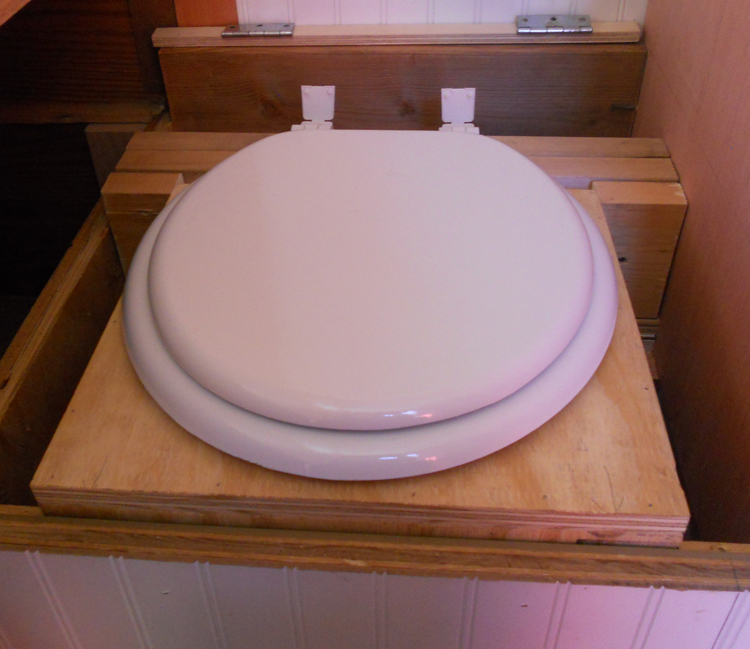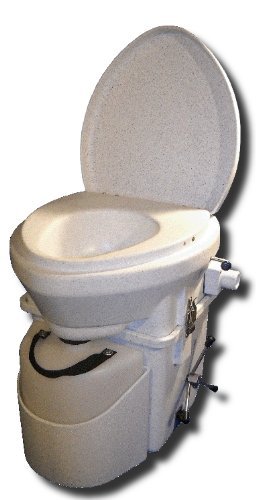The Home Composting Toilet
The home composting toilet can save the environment and your budget.

This is the home composting toilet my husband Rick built for our tiny home.
I doubt they'll be in every household someday, but I wish they were. They're simple to make and use and are truly one of the best investments for healthy soil and a cleaner world.
Cleaner, you might ask? Those who aren't familiar with this kind of commode, might be horrified at the thought of having one in a home. Stinky outhouses and those awful, plastic port,-a-potties come to mind.
But think again. The remarkable composting toilet doesn't smell and can save thousands of gallons of water each year.

What is a Composting Toilet?
Simply put, it stores human refuse, allowing it to break down, so it can be composted into rich humus you can use in your garden. Instead of being flushed into a septic system, which eventually leaks into the soil and can contaminate underground water tables, the waste is store until it breaks down completely and returns to harmless soil.
If done properly, all the pathogens are destroyed and you end up with pure, healthy soil.
Are Composting Toilets Safe?
This book is a good investment if you are worried about handling humanure.
According to Joseph Jenkins, author of the Humanure Handbook, most of the harmful pathogens found in human waste are destroyed within a few months of being composted.
If human waste is properly stored and let be for two years, every single pathogen is destroyed, and it becomes pure, safe soil.
If you're concerned at all, store the waste in buckets, seal them and leave them in the sun for a few years, and then use the soil for your flower gardens, but it truly will be safe enough for your vegetable gardens as well.
People around the world have been safely using humanure in gardens for centuries.
Why Use a Home Composting Toilet?
Dumping human waste into the water makes very little sense from an environmental standpoint. Why pollute the environment when you can turn your waste into a valuable resource instead?
And then there's the water waste. Toilets use at least five gallons of water with each flush. If the average family member flushes the toilet ten times a day, then a family of four will flush at least 200 gallons of water down the drain every day, or 73,000 gallons every year.
If you live in a town or city, it's even scarier. A small community of 2,000 people would be flushing away more than 146 million gallons of water into the sewer system every year. A lot of that water is treated and pumped back through our faucets, with which we drink, cook and bathe.
Urban water is treated to make it drinkable, but it isn't filtered, and trace amounts of pharmaceuticals, including antidepressants, are in every glass of urban water we drink. And by the way, if you live in the city, I highly recommend a good quality water filter.
We could have avoided this problem entirely if more people used home composting toilets.
Our Anti-Manure Culture

Sadly, most people would be horrified at the thought of a composting toilet, with visions of deadly diseases dancing through their heads.
We tend to think of human waste as a filthy, foul thing that must disappear, never to be seen again. And that's a real pity, because human waste can be valuable if handled properly.
And yes, it does need to be handled properly, but it's not as hard as you think.
How to Get a Composting Toilet
A commercially made toilet like this one might be a better option for town.
If you live in town, you might be wise to invest in a commercially made composting toilet.
I doubt that city ordinances will allow for anything else. Let's face it; home composting toilets still aren't accepted in most circles (You poop in a box? Are you insane????).
A commercially made composting toilet is expensive - a little less than $1,000 for one toilet at the time of this writing - but they will pay for themselves in the long run.
Their chief benefit is they look like an ordinary toilet.
Or Build Your Own
Home Composting Toilet
These are simple to make and don't smell if you handle them properly. All you need is a sturdy box about seat height with a hole in the center (you'll have a bucket underneath the hole) and a door in the front, so the bucket can be easily removed. Put a toilet seat over the hole and keep a bin of sawdust nearby.
Every time you make a deposit, cover your deposit with sawdust. If it still smells, cover it some more until it doesn't smell. The sawdust absorbs the moisture and the smell.
Handling the Waste
When the bucket is full, put the lid on tight and set the bucket out in the sun in an obscure place where children aren't likely to get at them. You can either leave the buckets alone for two years or place the contents in a compost bin.
The video below will show you how and was produced by Joe Jenkins.
Update:
One of my readers wrote in and asked how many buckets you would need for your home composting toilet, and also, where do you get sawdust? Here's my answer:
To get sawdust, my husband Rick says to go to a cabinet shop in your area and ask for sawdust. Cabinet shops and other companies that work with wood have a saw dust collection system, and the sawdust they collect is worthless to them. They'd be happy for you to come to collect it.
Most of the wood there is kiln-dried. The only wood you would worry about is that which is pressure treated, but that is almost never milled (sawed on in a workshop). Instead, they take that wood to the job site and wear a mask while working on it. It wouldn't be milled in a workshop.
As for the number of buckets, twelve five-gallon buckets would be fine. You made me laugh at the thought of a hundred buckets sitting in the sun. Once you get about ten buckets filled, you can then empty the buckets into your compost container and surround it with straw chips.












New! Comments
Have your say about what you just read! Leave me a comment in the box below.